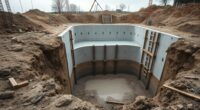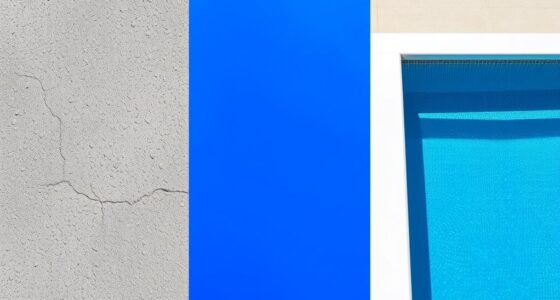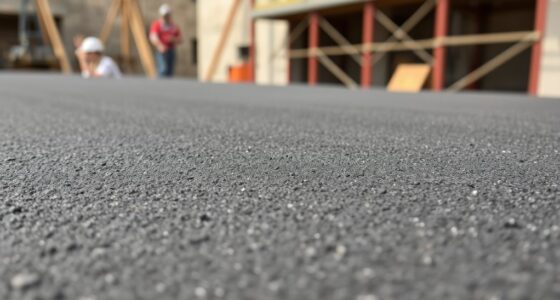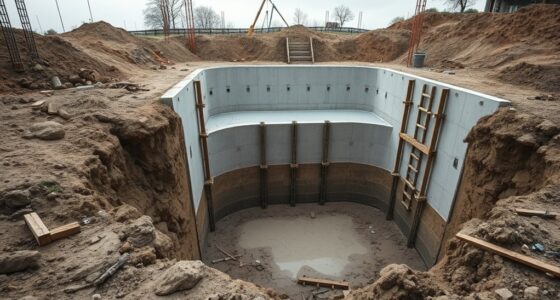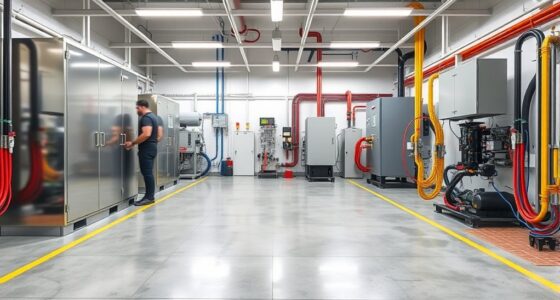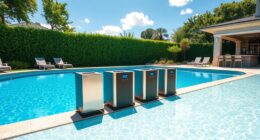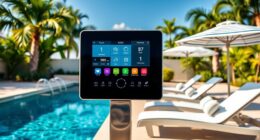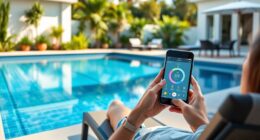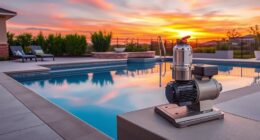To understand the flow path diagram in pool plumbing, you need to see how water moves from the skimmer and main drain to the pump, then through the filter, and back via return jets. The diagram shows key components working together to keep water clean and flowing smoothly. Recognizing each part’s role helps you troubleshoot and optimize your system. Keep exploring to learn how these elements connect for efficient circulation.
Key Takeaways
- Flow path diagrams illustrate how water moves from skimmer and drain through the pump, filter, and back to the pool.
- They help identify potential blockages, misconfigurations, or flow restrictions within the pool plumbing system.
- Understanding the diagram aids in proper valve placement and sizing for optimal water circulation.
- Visualizing flow paths improves troubleshooting and maintenance by showing water movement routes.
- Properly designed flow diagrams ensure efficient circulation, prevent stagnation, and prolong system lifespan.
Understanding the Main Components of Pool Plumbing
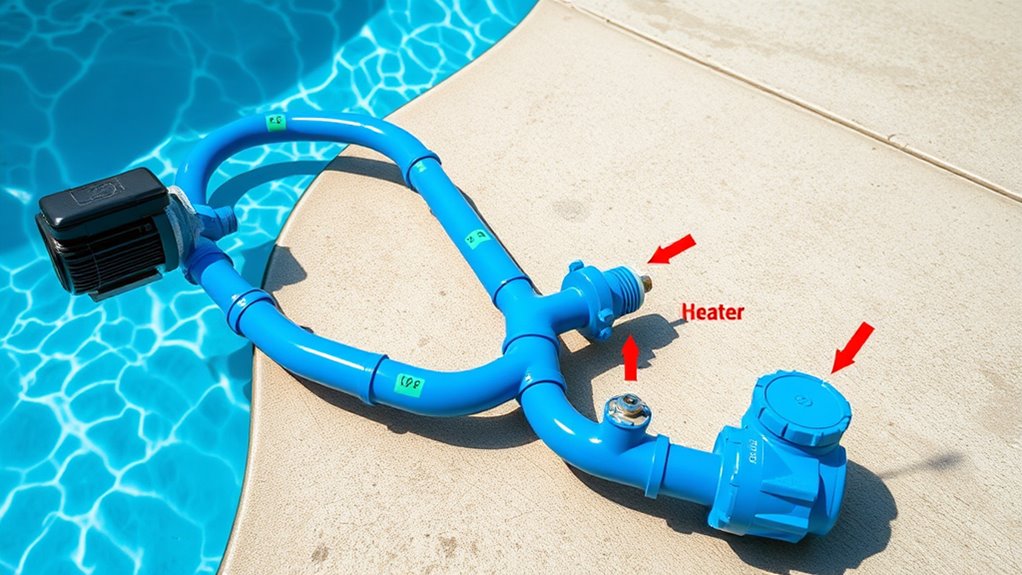
To keep your pool functioning smoothly, it is essential to understand the main components of its plumbing system. The primary parts include the skimmer, main drain, pump, and return jets. The skimmer sits at the surface and captures debris before water enters the pump. The main drain, located at the bottom of the pool, helps circulate water and prevents stagnation. The pump pulls water from these sources, creating the flow needed to filter and sanitize the water. Once filtered, the water is sent back through the return jets, redistributing clean water into the pool. Knowing how these components work together helps you troubleshoot issues and maintain optimal water quality, ensuring your pool stays clean, clear, and inviting. Regular maintenance and understanding pool plumbing can prevent costly repairs and extend the life of your pool system.
How Water Moves From the Skimmer to the Pump
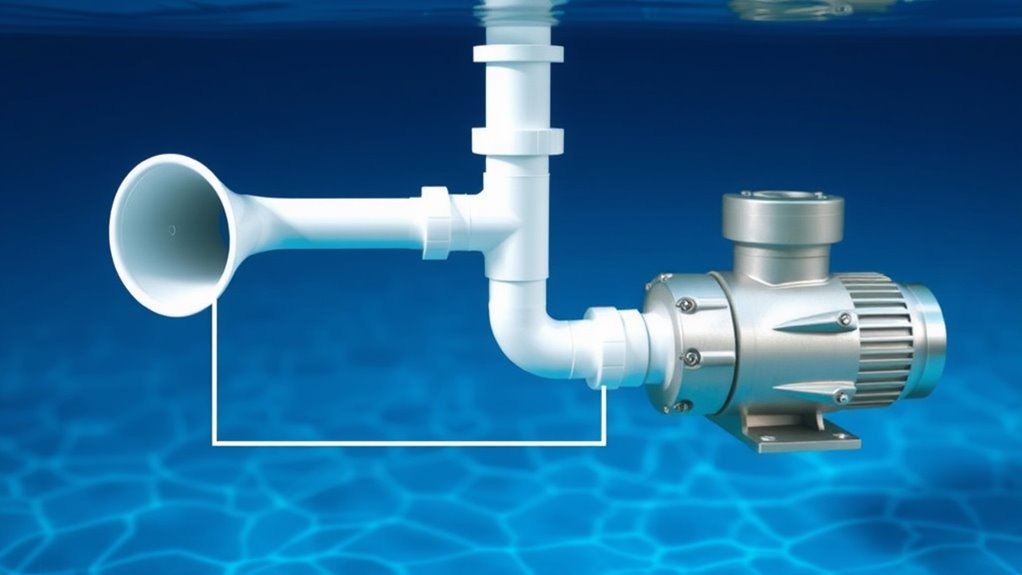
Water travels from the skimmer to the pump through a dedicated suction line that connects the two components. This line pulls water from the surface, removing debris and maintaining proper circulation. To guarantee smooth flow, consider these key points: 1. The suction line is usually a sturdy pipe designed to withstand pressure and prevent leaks. 2. A pool-specific valve, often a check valve, prevents water from flowing backward toward the skimmer. 3. A strainer basket inside the skimmer traps large debris, protecting the pump from clogs and damage. Additionally, ensuring proper pipe installation and regular maintenance helps sustain optimal water flow.
The Role of the Pump in Circulating Water

The pump is the heart of your pool’s circulation system, moving water through the filter and back into the pool. It’s essential for keeping the water clean and properly balanced. To do its job effectively, you need to understand how it maintains flow and efficiency. Proper pump maintenance ensures optimal performance and extends the lifespan of your equipment.
Pump’s Water Moving Role
Have you ever wondered how your pool stays clear and evenly circulated? The pump’s main job is to move water through the system, ensuring it flows smoothly from the skimmer, through the filter, and back. To do this effectively, the pump:
- Creates suction to draw water into the system.
- Uses internal impellers to accelerate water flow.
- Pushes water out through the return jets, distributing it evenly.
Your pump maintains continuous movement, preventing stagnation and helping filter debris. It’s essential for maintaining water clarity, chemical balance, and overall health of your pool. Without the pump’s active role, your pool water would become cloudy and unbalanced quickly. So, understanding how it moves water helps you appreciate its importance in your pool’s circulation system.
Maintaining Circulation Efficiency
To keep your pool’s circulation efficient, it’s essential to guarantee the pump operates at its best. Regularly check and clean the pump’s strainer basket to prevent debris from reducing flow. Ensure the pump’s motor runs smoothly without unusual noise or overheating, indicating proper functioning. Maintain the correct flow rate by adjusting the valve settings if needed. Keep an eye on pressure gauges; sudden drops or spikes signal issues that require attention. Consistently monitor for leaks or leaks signs around fittings and seals, which can diminish circulation. Schedule routine maintenance, including lubrication and part inspections, to prevent breakdowns. When your pump runs effectively, it moves water effectively, distributing chemicals evenly and keeping your pool clean and healthy. Additionally, inspecting for leak signs can help prevent significant water loss and maintain proper circulation.
Navigating the Filter and Its Importance

Understanding your pool filter is key to keeping your water clean and clear. Different filter types serve specific functions, so selecting the right one matters. Regular maintenance ensures your filter works efficiently and prolongs its lifespan. Proper filtration is similar to ECU tuning in vehicles, where fine-tuning can maximize performance and efficiency.
Filter Types and Functions
Ever wondered how a pool stays clean and clear? It all comes down to your filter system. Different filter types serve specific functions to keep water pristine. Here’s what you need to know:
- Sand Filters: Use sand to trap dirt and debris. They’re easy to maintain and ideal for average pools.
- Cartridge Filters: Employ replaceable cartridges to filter out particles. They’re efficient and require less backwashing.
- Diatomaceous Earth (DE) Filters: Use a fine powder to capture tiny particles, providing the clearest water.
- Proper filtration systems are essential for maintaining the self-sustaining moisture balance, similar to how self-watering plant pots regulate water to keep plants healthy.
Each type plays a pivotal role in circulating and cleaning your pool water. Choosing the right filter depends on your pool size, usage, and maintenance preferences. Proper filtration keeps your water sparkling and safe.
Proper Maintenance Practices
Maintaining your pool filter is essential for keeping your water clean and clear, and neglecting it can lead to costly repairs and poor water quality. Regularly check and clean the filter according to the manufacturer’s instructions—this prevents debris buildup that can hinder flow and reduce filtration efficiency. Backwash or rinse the filter when pressure gauges indicate high pressure, typically every few weeks. Replace filter media as needed to maintain peak performance. Keep an eye on circulation patterns to ensure water flows properly through the system. Also, monitor chemical levels to prevent algae growth and other issues. Lesser-known spots provide tranquil environments for cleaning and inspecting your equipment. Consistent maintenance not only extends your filter’s lifespan but also ensures your pool water remains crystal clear and safe for swimming.
Distributing Water to the Jets and Returns
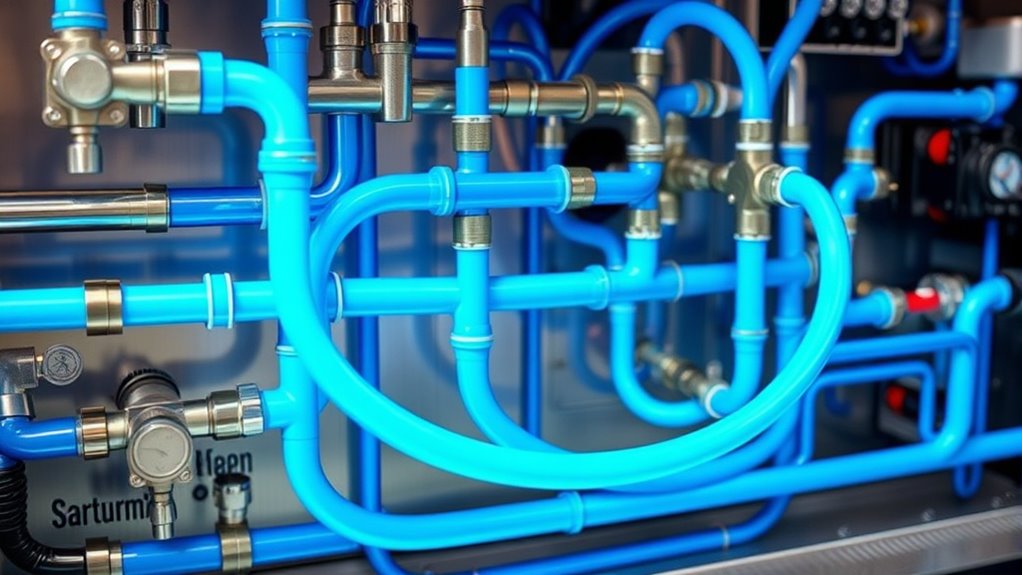
To guarantee your pool water circulates properly, you need a well-designed system for distributing water to the jets and returns. This system ensures even flow and effective filtration. First, you install multiple return fittings around the pool perimeter to spread water evenly. Second, you connect the jets to the main line, controlling water flow to create desired water movement and circulation. Third, you make sure the valves controlling each jet and return are easily accessible, allowing you to adjust flow rates as needed. Proper sizing of pipes and fittings is vital to prevent pressure loss and maintain flow. Additionally, understanding the flow path diagram helps in planning and troubleshooting the system effectively. By carefully distributing water through these components, you ensure good circulation, clearer water, and a more enjoyable swimming experience.
Returning Water to the Pool and Maintaining Circulation
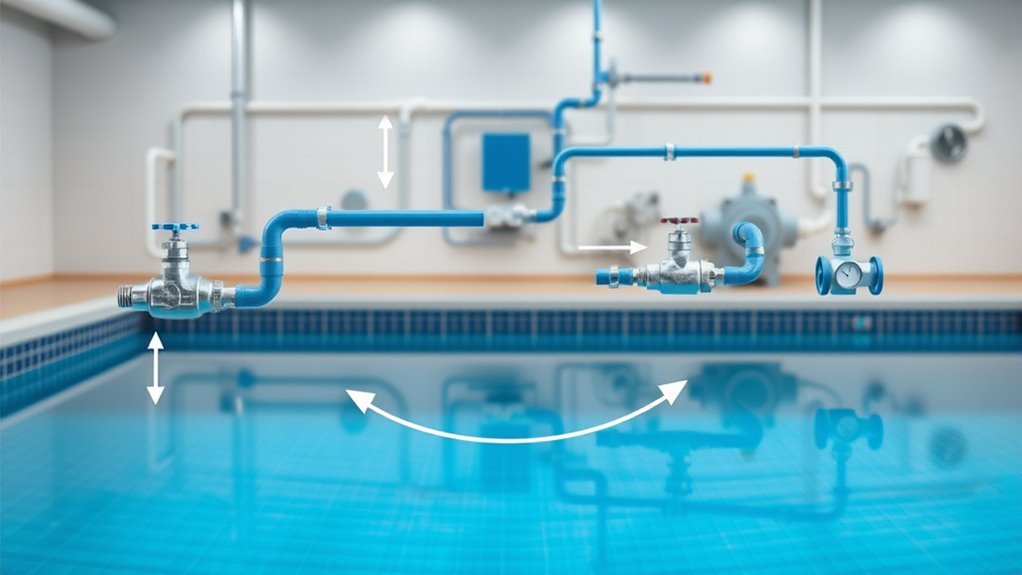
How can you guarantee that water returns smoothly to your pool and keeps the circulation consistent? First, ensure your return jets are properly positioned to distribute water evenly. Check that the pump maintains the correct flow rate, preventing stagnant areas. Properly sized and installed valves control flow direction, avoiding blockages. Regularly inspect for leaks or obstructions in the return lines. Additionally, understanding flow path diagrams can help visualize and troubleshoot circulation issues effectively.
Frequently Asked Questions
How Do I Troubleshoot Common Pool Plumbing Issues Effectively?
To troubleshoot common pool plumbing issues, start by inspecting the pump and skimmer baskets for debris. Check for leaks or cracks in pipes and fittings. Make certain the pump is primed and operating correctly. Listen for unusual noises and observe pressure gauges for abnormalities. If you notice low flow or pressure, identify blockages or closed valves. Regular maintenance and a systematic approach help you quickly pinpoint and fix problems.
What Safety Precautions Should I Follow During Plumbing Repairs?
You should always turn off the pool pump and power supply before starting repairs to prevent electrical shock. Wear protective gear like gloves and goggles to avoid injury from sharp components or chemicals. Make sure the area is dry and well-ventilated, and use proper tools to avoid accidents. If you’re unsure, consult a professional to guarantee safety and proper repair procedures.
How Often Should I Inspect and Maintain My Pool’s Plumbing System?
You should inspect and maintain your pool’s plumbing system at least once every season—otherwise, you’re risking catastrophe! Regular checks help catch leaks, clogs, or corrosion early, saving you from costly repairs later. Clear debris from skimmer baskets, tighten fittings, and test pressure levels routinely. Keep an eye on pump performance and listen for unusual noises. Consistent maintenance guarantees your pool runs smoothly, giving you peace of mind and crystal-clear water all season long.
Can I Upgrade My Pool Plumbing for Better Efficiency?
Yes, you can upgrade your pool plumbing for better efficiency. Start by evaluating your current system, then consider installing larger pipes or high-efficiency pumps to improve flow and reduce energy costs. Upgrading valves and filters can also enhance performance. Consult a professional to guarantee proper sizing and compatibility. Regular maintenance after upgrades helps maintain ideal efficiency and extends the lifespan of your upgraded plumbing system.
What Signs Indicate a Leak or Blockage in the Plumbing?
You’ll notice a leak or blockage if your pool’s water level drops unexpectedly, despite regular topping off. Watch for reduced water flow from jets or skimmers, strange noises like gurgling, or increased pressure in the pump. Also, if your pump runs longer than usual or there’s air in the system, these are signs of a problem. Regular inspections and listening for unusual sounds help catch issues early, preventing costly repairs.
Conclusion
Now that you understand the flow path of your pool’s plumbing, you’re better equipped to troubleshoot and maintain your system. Keeping everything running smoothly guarantees clean, clear water and a comfortable swim. Isn’t knowing how water circulates through your pool empowering? By familiarizing yourself with each component, you can spot issues early and keep your pool in top shape all season long. You’ve got this—happy swimming!

